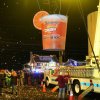Some big-box store wine is worth a look; trust your own tastebuds
Lawrence asked about Kirkland Wines, Costco’s proprietary label. I rarely review wine that can’t be found locally or shipped in. Costco is too far away, especially with current fuel and electric costs, to make shopping there effective. Recognizing that many readers are second-homers or commute north, I decided to respond. Most of Kirkland's is wine bought by blenders, which renowned labels did not wish to include in their product for a variety of reasons. Most blenders are terrific chefs; others are a bit less talented. Often they are named on the back label. Most other big-box sellers don't provide this info. Kirkland Signature Series Stags Leap District Cabernet Sauvignon is an 88-point blend. The Oakville is a good value, Rutherford and Napa County not so much. The 2017 vintage from most of Napa was a disappointment, around 85 McD. The rain was torrential and the fires were horrible. Costco is a careful buyer. Keeping in mind that these are “cheap” wines – many are in the under-$8 range, and their 3L box wines are usually under $15 – they may earn price points. Experience informs me that some critics will give lower reviews to less-expensive wines when labels aren’t obscured or the hosts aren’t especially hospitable. Kirkland wines are vintage dependent. Barolo, Rioja, Malbec, Toscana and Gigondas are usually good-value reds most years. If you go to Reverse Wine Snob: reversewinesnob.com/kirkland-signature-series-oakville-cabernet-sauvignon, scroll down and open "you will also like," you will find a complete look at Kirkland Signature series red, white, rosé and sparklers. Jon Thorsen is a fine reviewer, and that page touches on their entire spectrum. My main issues with shopping these: Frequently they are designed to appeal to everyone, sort of a dumbing-down to the middle, if you will, and I’ve found inconsistent profiles on blends that are not vintage driven. One should expect NVs to be similar year to year. All that writ, there are always several good choices in any year. Thorson does a good job reviewing these on a regular basis.
Some caveats! Don’t let price or shelf placement trick you. Find reviewers who consistently recommend wine you find you enjoy. Go to tastings to expose yourselves to a diverse range of products. Drink in recommended aging window. Contrary to the canard, nearly all whites and Methode Champenoise improve remarkably with some age. They were made that way. Nearly all wines also have a toss date. However, I have found in a gloomy corner some too-old wine that was still quite good; and also a turned red, reduced and simmered with sauteed onions and Espagnole, makes a delicious sauce. Most drink wine too young. Enjoy wine with food recommendations. Sample a glass of wine over an hour to observe how temperature affects it. Most of us drink wine at inappropriate temperatures. The impact is dramatic. Reams have been written on this subject, but pouring a glass of too-cold wine, and allowing it to warm over time as you sip, will immediately inform most in one try.
This Bloomberg headline and article should disturb all of us. “World’s Central Banks Set Policy for Economies Shaken by the War.” How many realize the import of a bunch of unelected bankers and economists colluding to set policies? Since Jekyll Island, these one-worlders have brought most of us nothing but flip-flop financial agony and ecstasy, supply chain failures and excesses, pandemics, wars, manufactured shortages, rampant inflations and recessions. A plethora of poor policies has led to dramatic wealth disparity. Regarding oligarchs, according to Forbes and Time, opposite sides of media political spectrum, the number of billionaires increased by 660 to 2,755 last year, with 724 from USA and 698 China, Macao and Hong Kong. Apparently free market and socialism have little to do with it. In aggregate, they now control $13.1 trillion, up from $8 trillion one year ago. Nine of the top 10 and 20 of the top 30 wealthiest people are U.S. citizens. Nos. 13, 15, 21 and 26 are from China. The first Russian is No. 51 and the next No. 55. This is not about wealth, or U.S. vs. Russia or China. Cui bono?



















































